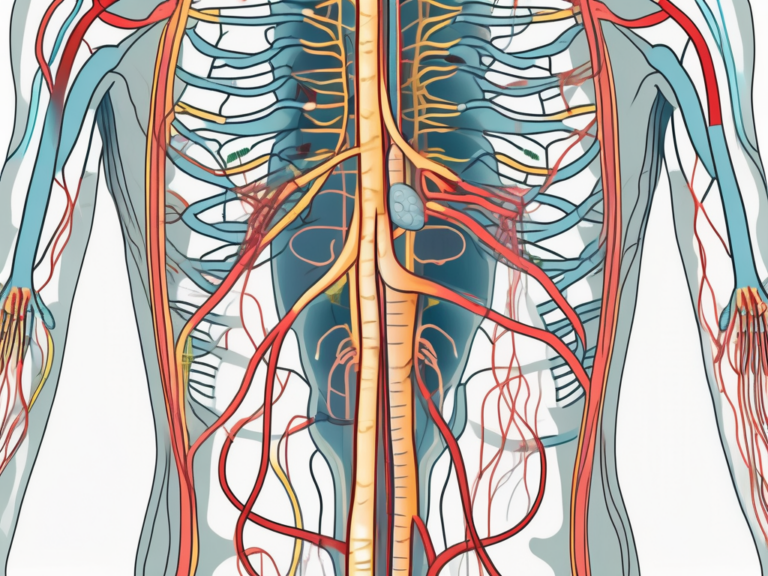The Role of the Glossopharyngeal Nerve in Swallowing and Taste Sensation
The glossopharyngeal nerve plays a crucial role in both swallowing and taste sensation. Understanding the anatomy and functions of this nerve is essential in comprehending the complex mechanisms involved in these processes. Furthermore, exploring the disorders related to the glossopharyngeal nerve and the potential effects of damage on swallowing and taste perception sheds light on the importance of this nerve in everyday life. As researchers continue to delve into the intricate workings of the glossopharyngeal nerve, new insights and potential therapeutic approaches for various disorders may emerge. This article aims to provide an in-depth exploration of the glossopharyngeal nerve and its significance in the realms of swallowing and taste sensation.
Understanding the Glossopharyngeal Nerve
The glossopharyngeal nerve, also known as cranial nerve IX, is one of the twelve cranial nerves in the human body. It originates in the medulla oblongata, a vital part of the brainstem, and travels through the skull, neck, and throat. This nerve serves as a key connector between the brain and various organs and tissues involved in swallowing and taste perception.
Anatomy of the Glossopharyngeal Nerve
The glossopharyngeal nerve primarily innervates the tongue, pharynx, and salivary glands. It consists of both sensory and motor fibers, allowing for bidirectional communication between these structures and the brain. The sensory fibers carry information from the tongue and throat to the brain, while the motor fibers enable the muscle contractions necessary for swallowing.
Functions of the Glossopharyngeal Nerve
The glossopharyngeal nerve serves multiple functions related to swallowing and taste sensation. In terms of swallowing, it plays a pivotal role in coordinating the complex sequence of muscle contractions required to move food from the mouth to the stomach. Additionally, it facilitates the proper closure of the airway during swallowing, preventing food or liquid from entering the respiratory tract.
But the glossopharyngeal nerve’s involvement in taste perception goes beyond the basic recognition of flavors. It also contributes to the intricate process of gustation, which involves the integration of taste, smell, and texture sensations to create our overall perception of food. This complex interplay of sensory information allows us to savor the delicate nuances of different cuisines and enjoy the rich tapestry of flavors that the world has to offer.
Furthermore, the glossopharyngeal nerve is not limited to the tongue alone when it comes to taste perception. It also extends its reach to the tonsils and the soft palate, enhancing our ability to detect and appreciate a wide range of tastes. This comprehensive sensory network ensures that our taste buds are not only limited to the tip of our tongues but extend throughout the oral cavity, providing us with a more holistic experience of flavor.
The Glossopharyngeal Nerve and Swallowing
Swallowing is a complex process that involves several organs and muscles working in harmony. The glossopharyngeal nerve plays a crucial role in this intricate mechanism.
Understanding the detailed intricacies of swallowing can shed light on the remarkable coordination required for this seemingly simple act. From the moment food enters the mouth to its journey through the digestive system, a series of precise movements and neural signals orchestrate a seamless process.
Mechanism of Swallowing
The process of swallowing can be divided into three main stages: the oral phase, the pharyngeal phase, and the esophageal phase. During the oral phase, food is formed into a cohesive bolus and moved towards the back of the mouth by the tongue. As the bolus reaches the pharynx, the pharyngeal phase begins.
In the pharyngeal phase, the soft palate and the epiglottis work together to prevent food or liquid from entering the nasal cavity or the trachea, respectively. The glossopharyngeal nerve, along with other cranial nerves, facilitates the contraction of the pharyngeal muscles, which propels the bolus into the esophagus.
Transitioning into the esophageal phase, the intricate coordination of muscular contractions ensures the smooth passage of the bolus into the stomach. This phase highlights the seamless handover between neural control and muscular action, showcasing the body’s remarkable ability to execute complex tasks effortlessly.
How the Glossopharyngeal Nerve Facilitates Swallowing
The glossopharyngeal nerve provides sensory feedback during swallowing, allowing the brain to monitor the progress of the bolus. This feedback helps ensure the proper coordination of muscle contractions and the timely progression of the bolus through the gastrointestinal tract.
Moreover, the glossopharyngeal nerve’s role extends beyond the mechanical aspects of swallowing. It also contributes to the autonomic control of salivation, further emphasizing its significance in the overall process of digestion. This intricate interplay between neural pathways and physiological responses showcases the multifaceted nature of the body’s mechanisms.
The Glossopharyngeal Nerve and Taste Sensation
The ability to perceive different tastes is a fundamental aspect of our gustatory experience. The glossopharyngeal nerve plays an integral role in transmitting taste information from the tongue to the brain.
The Science of Taste
Taste perception is not solely dependent on the tongue; it involves multiple factors, including taste buds, taste receptors, and cranial nerves. Taste buds are clusters of specialized cells that detect and transmit taste signals. Taste receptors, located on these cells, bind with specific molecules in food to initiate the taste perception process.
Taste perception requires the involvement of multiple cranial nerves, with each nerve responsible for transmitting taste information from a specific region of the tongue to the brain. The glossopharyngeal nerve handles taste information from the posterior third of the tongue, making it a vital component in our ability to discern various tastes.
Furthermore, the process of taste perception is not limited to just the tongue. It also involves the olfactory system, where our sense of smell interacts with taste to create complex flavor profiles. This interaction between taste and smell is why food may taste different when we have a cold, as our ability to smell is compromised.
The Role of the Glossopharyngeal Nerve in Taste Perception
Upon stimulation of taste receptors in the posterior third of the tongue, the glossopharyngeal nerve transmits signals to the brain, prompting the perception of taste. This intricate signaling process allows us to differentiate between different tastes and derive pleasure and satisfaction from our food.
Moreover, the glossopharyngeal nerve is not only involved in taste perception but also plays a role in other important functions such as swallowing and monitoring blood pressure. This multifaceted nerve highlights the interconnected nature of our bodily systems, showcasing the complexity of human physiology.
Disorders Related to the Glossopharyngeal Nerve
As with any part of the nervous system, the glossopharyngeal nerve can be affected by various disorders, resulting in a range of symptoms and challenges.
The glossopharyngeal nerve, also known as cranial nerve IX, plays a crucial role in the sensation and movement of the throat and tongue. When this nerve is affected by disorders, it can lead to disruptions in swallowing, speech, and taste perception, impacting the individual’s overall quality of life.
Symptoms and Diagnosis of Glossopharyngeal Nerve Disorders
Glossopharyngeal nerve disorders can manifest in different ways, including difficulty swallowing, pain in the throat or tongue, altered taste perception, or a combination of these symptoms. Establishing a correct diagnosis of glossopharyngeal nerve disorders can be challenging, as these symptoms can overlap with other conditions. Specialized neurological assessments, imaging, and other diagnostic tests may be necessary to determine the underlying cause.
In addition to the common symptoms mentioned, individuals with glossopharyngeal nerve disorders may also experience referred pain to the ear or the jaw, further complicating the diagnostic process. The intricate network of nerves in the head and neck region requires a comprehensive evaluation by healthcare professionals to pinpoint the exact source of the issue.
Treatment and Management of Glossopharyngeal Nerve Disorders
Effective treatment and management strategies for glossopharyngeal nerve disorders depend on the underlying cause and severity of the condition. Medication, physical therapy, and in some cases, surgery may be employed to alleviate symptoms and improve the patient’s quality of life. It is essential to consult with a healthcare professional specializing in neurology or otolaryngology to determine the most appropriate course of action.
Furthermore, lifestyle modifications such as dietary changes and speech therapy may also be recommended to address specific symptoms associated with glossopharyngeal nerve disorders. A multidisciplinary approach involving various healthcare providers is often necessary to ensure comprehensive care and optimal outcomes for individuals facing these challenging conditions.
The Impact of Glossopharyngeal Nerve Damage
Damage to the glossopharyngeal nerve can have significant effects on both swallowing and taste perception, potentially impacting various aspects of an individual’s daily life.
The glossopharyngeal nerve, also known as the ninth cranial nerve, plays a crucial role in the complex process of swallowing. When this nerve is damaged, it can lead to dysphagia, a condition characterized by difficulty in swallowing. Dysphagia can manifest as challenges in moving food from the mouth to the esophagus, increasing the risk of aspiration and malnutrition. Individuals with glossopharyngeal nerve damage may experience symptoms such as coughing while eating, a sensation of food getting stuck in the throat, or persistent throat clearing. Addressing these swallowing difficulties requires a comprehensive treatment plan tailored to the specific needs of the individual.
Effects on Swallowing and Eating
Glossopharyngeal nerve damage can lead to swallowing difficulties, also known as dysphagia. This can result in a range of challenges, such as choking, regurgitation, and reduced nutritional intake. Furthermore, dysphagia can significantly impact an individual’s overall physical health and well-being. Proper diagnosis and management of glossopharyngeal nerve damage are crucial for minimizing these adverse effects.
In addition to the physical challenges posed by dysphagia, individuals with glossopharyngeal nerve damage may also experience emotional and social impacts. Difficulties with swallowing can lead to feelings of embarrassment or isolation, especially in social settings involving food. Addressing the psychosocial aspects of dysphagia is an essential component of holistic care for individuals dealing with glossopharyngeal nerve damage.
Effects on Taste and Flavor Perception
Glossopharyngeal nerve damage can affect taste perception, leading to a diminished ability to detect certain tastes or altering one’s perception of flavors. This can significantly impact an individual’s enjoyment of food and may contribute to nutritional imbalances. Multidisciplinary approaches involving nutritionists, speech therapists, and other specialists can help individuals cope with the challenges posed by these alterations in taste perception.
Furthermore, changes in taste perception resulting from glossopharyngeal nerve damage can extend beyond just the experience of eating. Individuals may find that their preferences for certain foods shift, or that they have an increased or decreased sensitivity to flavors. Exploring strategies to enhance the sensory experience of food, such as experimenting with different textures or seasonings, can be beneficial for individuals navigating these taste-related changes.
Future Research Directions in Glossopharyngeal Nerve Function
Ongoing research into the glossopharyngeal nerve continues to uncover new insights and potential therapeutic approaches for various disorders related to swallowing and taste sensation.
Advances in Neurological Understanding
Advancements in neuroimaging techniques, such as functional magnetic resonance imaging (fMRI), allow researchers to observe the brain activity associated with taste perception and swallowing. By gaining a better understanding of the neural networks involved in these processes, researchers can identify potential targets for therapeutic interventions and refine existing treatment strategies.
Potential Therapeutic Approaches
Research exploring potential therapeutic approaches for glossopharyngeal nerve disorders is ongoing. This includes investigating the effects of innovative therapies, such as electrical stimulation or targeted drug delivery, on restoring or improving swallowing function and taste perception. While these approaches are still in early stages, they hold promise for the future of managing glossopharyngeal nerve-related conditions.
Furthermore, recent studies have focused on the role of the glossopharyngeal nerve in the regulation of blood pressure. It has been discovered that this cranial nerve plays a crucial role in monitoring blood pressure levels and relaying information to the brain. Dysfunction of the glossopharyngeal nerve can lead to conditions such as hypertension or hypotension, highlighting the importance of further investigating its role in cardiovascular health.
In addition to its role in swallowing and taste perception, the glossopharyngeal nerve also contributes to the regulation of salivation. Research has shown that this cranial nerve is responsible for stimulating the salivary glands, which aids in the digestion process. Understanding the intricate mechanisms involved in glossopharyngeal nerve-mediated salivation can provide valuable insights into the development of treatments for conditions such as xerostomia, or dry mouth.
In conclusion, the glossopharyngeal nerve plays a vital role in both swallowing, taste sensation, blood pressure regulation, and salivation. Understanding its anatomy, functions, and involvement in various disorders provides valuable insights into the complexities of these fundamental processes. As researchers continue to unravel the mysteries of the glossopharyngeal nerve, new possibilities for enhancing diagnosis, treatment, and management of related conditions may emerge, ultimately improving the quality of life for individuals affected by glossopharyngeal nerve disorders.






